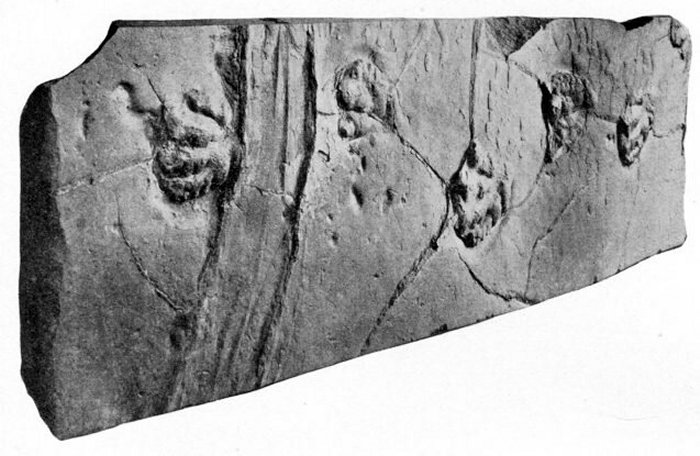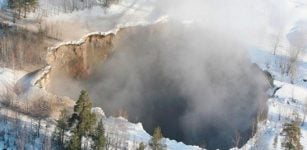200-Million-Year-Old Secret Discovered On Stone Slab In Connecticut
Eddie Gonzales Jr. – MessageToEagle.com – The stone slab has been on display since 1896, but no-one noticed it offers evidence of important climate events. When scientists re-examined the rock, they discovered a 200-million-year-old secret.
Kept at the Dinosaur State Park in Connecticut, the state where it was originally discovered, the sandstone slab is prized for its detailed dinosaur footprints. However, researchers now say it may also contain the track of a sailing stone or “walking rock.”

This slab of sandstone has been on display since 1896, showing off the scaly footprints of a prosauropod dinosaur. Scientists only recently realized that the deep grooves on the left may be the track of a sailing stone. Credit: Lull, R.S., 1915
According to Paleontologist Paul Olsen from Lamont-Doherty Earth Observatory and his colleagues, the trail of the walking rock is evidence of a brief freezing event in the tropics some 200 million years ago.
This means it’s the first evidence that volcanic winters reached into the humid tropics during the dawn of the dinosaur age.
The stone slab shows off the scaly footprints of a Brontosaurus predecessor that lived in the tropics during the Early Jurassic period.
What Are Sailing Stones?
Sailing stones are rocks and boulders move across flat landscapes without the help of gravity, people, or animals, carving tracks as they go. How do they move? Scientists know of two ways: by sliding on thick, slimy microbial mats, and when they’re pushed by thin ice sheets that form temporarily over shallow lakes.

Sailing stones in the Death Valley. Credit: Public Domain
The researchers can’t say for sure whether it was one sailing stone or several that scraped this particular surface, but whatever it was, it was heavy enough to dig significant grooves in the ancient mud.
A heavy object requires a thick microbial mat to lubricate its movement, but if such a thick mat was present, it would have prevented the detailed dinosaur footprints from forming.
“When the microbial mat gets thick, it actually shields the mud from the details of the foot,” explains Olsen. Furthermore, he adds, the surface doesn’t bear any of the usual markings of a thick microbial mat.
How Did The Stone Slab Reach Connecticut?
That left the other explanation: that the object was pushed by ice. That was surprising, because the track was laid down back when Connecticut was located at around the same latitude as the modern-day Yucatan peninsula. The site was at a relatively low elevation that would have experienced a tropical climate, and through most of the beginning of the Age of Dinosaurs, many of the animals and plants in the region were frost-intolerant. “There are no reasons to think that freezing would be a normal situation there,” says Olsen.
However, he and his colleagues have a potential explanation. The sandstone was deposited during the last of a series of eruptions that caused a mass extinction.
See also:
Giant Human-Sized Penguins Ruled The World After Dinosaurs Died Out
Giant Leatherback Sea Turtle – World’s Largest Sea Turtle Survived The Extinction Of The Dinosaurs
Prehistoric Forest Discovered On Antarctica – It Existed Long Before Dinosaurs Roamed The Earth
The eruptions also blasted huge amounts of sulfur aerosols into the atmosphere that likely produced brief periods of global cooling, by shielding the Earth from receiving a normal amount of sunlight.
However, paleoclimatologists don’t know how much sulfur was dumped into the atmosphere or how much cooling occurred. The new finding suggests that the planet may have cooled to such an extent that even the tropics froze.
“This may be evidence of the cooling caused by the volcanic winter,” says Olsen.
If the massive cooling event did reach the tropics, it is possible that the dinosaurs’ feathers provided insulation that helped them to survive the cold.

If a volcanic winter did occur in the tropics 200 million years ago, feathers and fur may have helped these two to survive the cold. Credit: Paul Olsen
At the global scale, the freezing conditions during this time wiped out large non-insulated reptiles on land, opening up ecological space for insulated dinosaurs to dominant the planet.
Olsen cautions that the volcanic winter interpretation is “is not iron-clad,” because the team can’t entirely rule out the possibility that microbial mats allowed the rocks to sail.
Fortunately, there is a way to solve the mystery: If there were thin ice sheets in this region, then they likely moved other rocks as well. “If you could find them moving in synchrony, that would really indicate that it was ice, without a question,” says Olsen.
The team also discovered the footprints of a primitive mammal in the same sandstone slab, which had similarly gone unnoticed for more than 100 years. The mammal, sailing stone, and dinosaur likely passed by the same spot within a few days or weeks of each other.
Written by Eddie Gonzales Jr. – MessageToEagle.com Staff










